
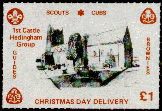
Types 1 and 2, 27x36mm & 53x36mm, designed by John Redgewell, Steve Wooding, Glyn Brassington in association with J Newman of the printers, Colne Valley Printers, Halstead, Essex. Line rouletted about 10. Lithographic process. Sheet format 6 rows of ten stamps, each row 9x10p + 1x£1. Separate first day covers were produced for the two stamps on specially designed and printed grey envelopes .

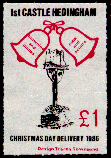
Types 3 and 4, 31x35mm & 35x51mm, designed by Tracey Townsend, printed by lithography by Colne Valley Printers, Halstead, Essex. Line rouletted about 10. Sheet format 6 rows of ten stamps, each row 9x10p + 1x£1. Separate first day covers were produced for the two stamps on specially designed and printed maroon envelopes .

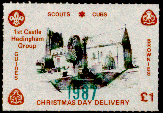
Types 5 and 6, 27x36mm & 53x36mm, types 1 and 2 overprinted "1987". Separate first day covers were produced for the two stamps on specially designed and printed envelopes (both grey and maroon envelopes from the last two years were re-used).

Type 7, 27x36mm, type 1 overprinted "-- DEC 1988". A first day cover was produced on specially designed and printed envelopes (grey envelope from 1985 re-used).

Type 8, 31x35mm, type 3 overprinted "1989". A first day cover was produced on a specially designed and printed envelope. A booklet containing ten stamps was produced.
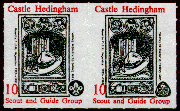
Types 9 and 10, 30x36mm, designed by John Redgewell, printed by R. Phillips of Wembley Scouts in booklet panes of ten, two rows of 5, first row types 10/9/10/9/10, second row types 9/10/9/10/9. Line rouletted about 10. A first day cover was produced on a specially designed and printed envelope. A booklet containing ten stamps was produced.

Types 11 and 12, 30x36mm, designed by John Redgewell, printed by R. Phillips of Wembley Scouts. Line rouletted about 10. Booklet pane two rows of 5, first row types 12/11/12/11/12, second row types 11/12/11/12/11. A first day cover was produced on a specially designed and printed envelope. A booklet containing ten stamps was produced.
The service continued in 1992, using up spare un-overprinted stamps from previous years, mostly those from 1989/90. Almost any 10p stamp can be found with a 1992 cancellation.
Service inactive.
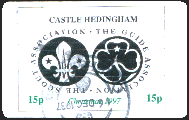
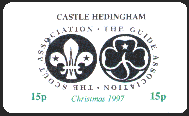

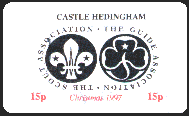
Types 13 to 16, designed by ?, computer printed with an ink-jet printer on sheets of self-adhesive labels. No FDCs produced. The arrangement of the boxed & unboxed designs within the same (or separate) sheets is not known.
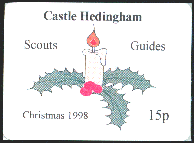
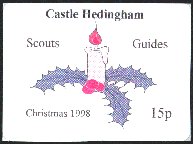
Types 17 to 18, designed by ?, computer printed with an ink-jet printer on sheets of self-adhesive labels. No FDCs produced. Very variable in colour - the two examples given are the extremes of what is actually a gradual progression presumably due to fluctuations in the ink supply whilst printing.
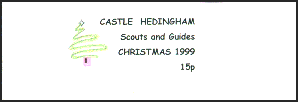
Type 19, designed by ?, computer printed on an ink-jet printer on sheets of self-adhesive labels. No FDCs produced. Vary variable in alignment with top/bottom of label - see the sheet layout for details.
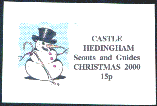
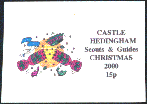
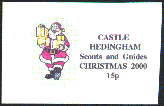

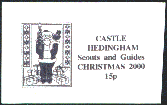
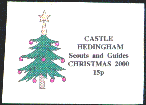
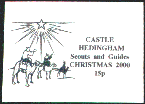
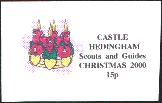
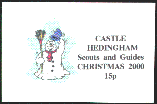


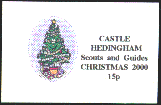
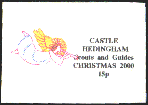
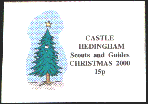
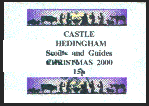
Types 20 to 34, designed by ?, computer printed on an ink-jet printer, 2 stamps per label, on the first 7 rows of 2 labels of A4 sheets of 16 self-adhesive labels (bottom row of two labels left blank) giving 28 stamps per sheet. They were then separated before distribution into vertical strips of 7 so no sheet images can be produced. The guillotining was very uneven so the stamp size is very variable.
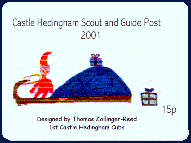
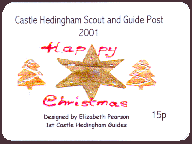
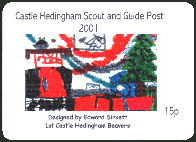
Types 35 to 37, designed by ?, computer printed on an ink-jet printer on sheets of self-adhesive labels.
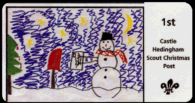
Type 38, 64x34mm designed by a cub, computer printed on an ink-jet printer on sheets of 24 (8 rows of 3) self-adhesive labels.
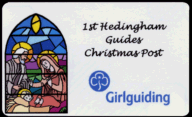
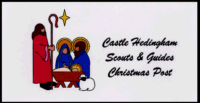
Types 39 to 40, designed by leaders using clip-art, computer printed on an ink-jet printer on sheets of 21 (7 rows of 3) self-adhesive labels of type 39 or 24 (8 rows of 3) of type 40, the last row of each being inverted.
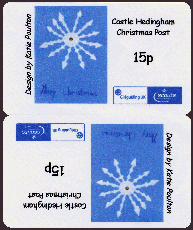
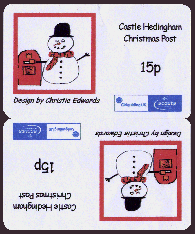
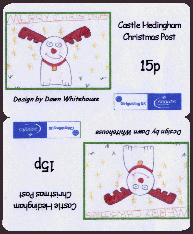
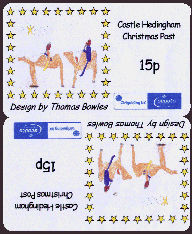
Types 41 to 44, designed by members Katie Poulton, Christie Edwards, Dawn Whitehouse & Thomas Bowles, computer printed on an ink-jet printer on sheets of 21 (7 rows of 3) self-adhesive labels, the last row of each being inverted.
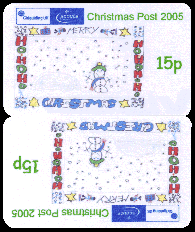
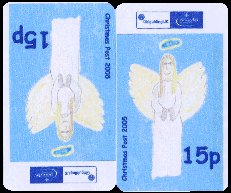
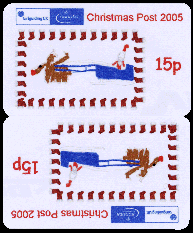
Types 45 to 47, designed by members, computer printed on an ink-jet printer on sheets of 21 (7 rows of 3) self-adhesive labels, the last row of each being inverted.

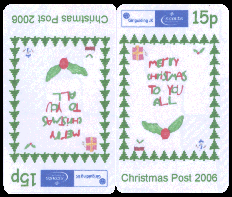
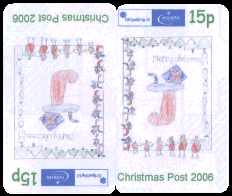
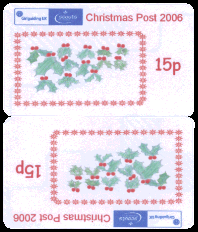
Types 48 to 51, designed by members, computer printed on an ink-jet printer on sheets of 21 (7 rows of 3) self-adhesive labels, the last row of each being inverted.
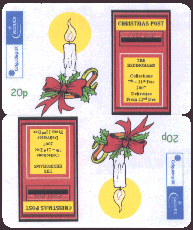
Type 52, designed by a member, computer printed on an ink-jet printer on sheets of 21 (7 rows of 3) self-adhesive labels, the last row being inverted.
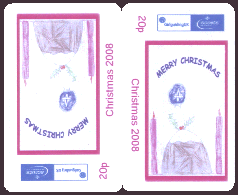
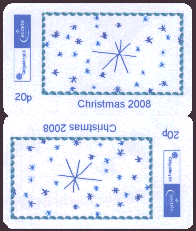
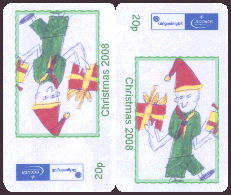


Types 53 to 57, designed by members, computer printed on an ink-jet printer on sheets of 21 (7 rows of 3) self-adhesive labels, the last row of each being inverted.

Type C1/P1 - used on ordinary mail and FDCs from 1985-1992, either as a cancel applied to the 10p stamp or as a separate cachet on the FDC (1985-1988).

Type C2/P2 - used on FDCs from 1985-1988, either as a cancel applied to the 10p stamp or as a separate cachet on the £1 FDC. Also used on full-set FDCs in 2001.

Type C3/P3 - used on FDCs from 2000, either as a cancel applied to the stamp on an FDC with a set of three stamps (2001 only) or as a separate cachet on single-stamp FDC.

Type P4 - used on special "Christmas day delivery" cards from 1985-1987.

Type P5 - used on ordinary mail from 2000 and FDCs from 2001.
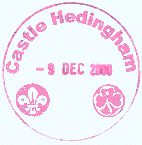
Type P6 - used on ordinary mail from 2001 and single-stamp FDCs from 2000.
| Year | 1981 | 1982 | 1983 | 1984 | 1985 | 1986 | 1987 | 1988 | 1989 | 1990 |
| Start | None | None | None | None | Dec 9 | Dec 10 | Dec 14 | Dec 12 | Dec 11 | Dec 10 |
| Printed | None | None | None | None | 8,000 | 5,000 | 0 | 0 | 0 | 3,000 |
| Carried | None | None | None | None | 3,500 | 2,450 | 1,804 | 1,931 | 1,773 | 1,830 |
| Year | 1991 | 1992 | 1993 | 1994 | 1995 | 1996 | 1997 | 1998 | 1999 | 2000 |
| Start | Dec 9 | Dec 14 | None | None | None | None | . | . | . | . |
| Printed | 2,000 | 0 | None | None | None | None | . | . | . | . |
| Carried | 1,688 | 1,401 | None | None | None | None | . | . | . | . |
| Year | 2001 | 2002 | 2003 | 2004 | 2005 | 2006 | 2007 | 2008 | 2009 | 2010 |
| Start | Dec 11 | . | . | . | . | . | . | . | None | None |
| Printed | . | . | . | . | . | . | . | . | None | None |
| Carried | . | . | . | . | . | . | . | . | None | None |
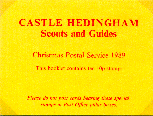
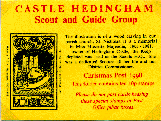
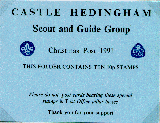
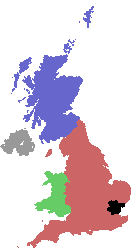
Return to Essex Index
Return to Alphabetic Index - C
Return to Scout County of Essex Index